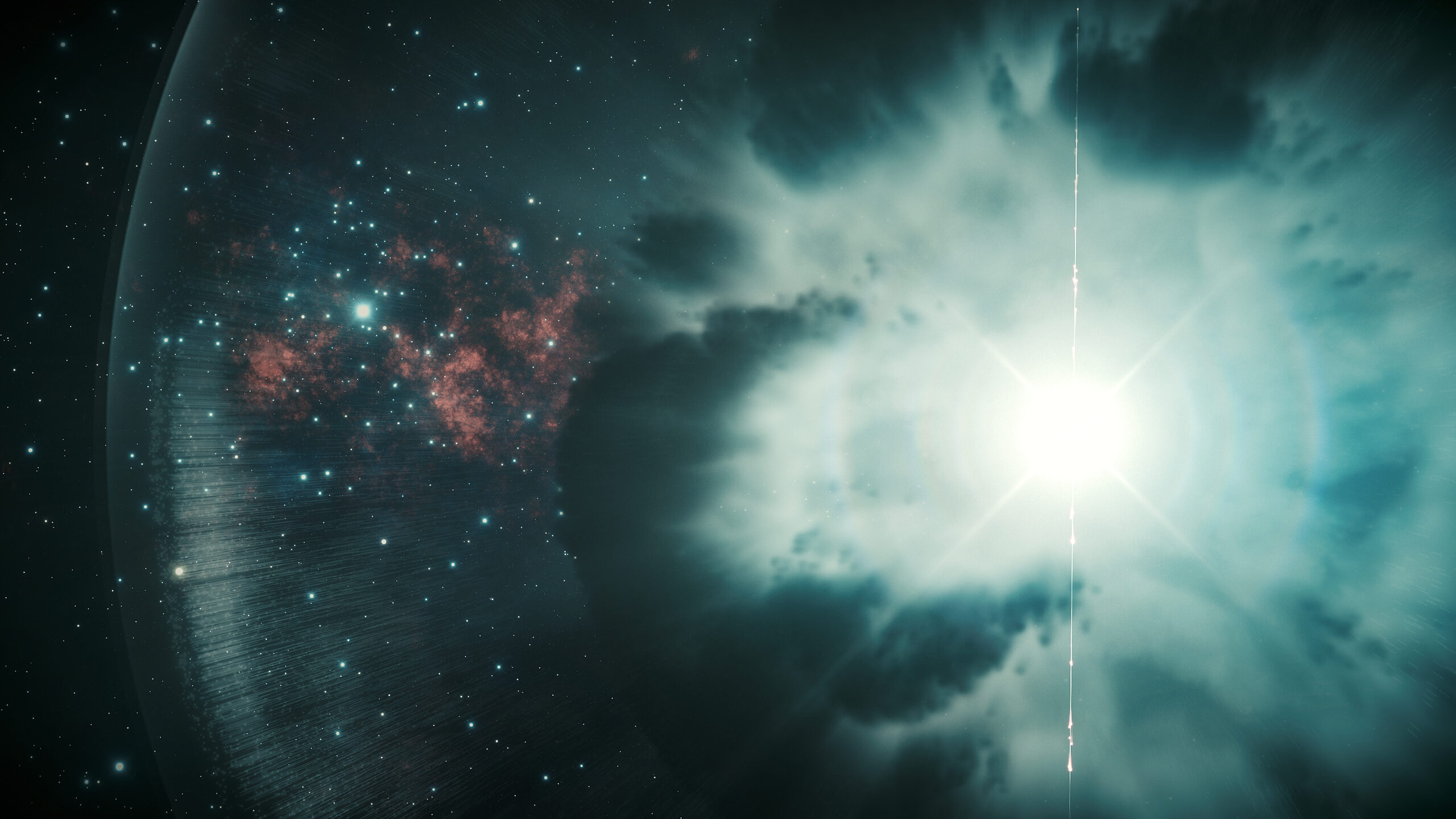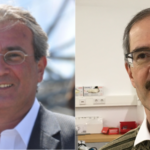
Very first measurements of GRBs from ground – a breakthrough in high-energy gamma-ray observations
Interview with Razmik Mirzoyan and Stefan Wagner on their successful measurements of GRBs with MAGIC and H.E.S.S.
On 14 January 2019, Swift has reported the detection of a long GRB 190114C (GCN #23688). The MAGIC telescopes started observations of this GRB about 50 s after the Swift-BAT alert, reaching more than 20 sigma of significance in 2 hours. At the CTA Science Symposium on 6-9 May 2019, also H.E.S.S. announced the detection of GRB 180720B in its afterglow phase at the level of 5 sigma in about 2 hours of observations. Three papers on these relevant findings where later published in Nature. We would like to congratulate on this major breakthrough and interviewed the two spokespersons of the experiments, Razmik Mirzoyan and Stefan Wagner.
MAGIC observed bright early emission from GRB 190114C in January 2019, H.E.S.S. the faint afterglow emission of GRB 180720B in July 2018. What do you think led to the breakthrough in these observations?
Mirzoyan:
MAGIC detection of the GRB 190114C has been published in ATel #12390 and the GCN Circular #23701 in the night of 14/15th January 2019. MAGIC detected the most intense ever gamma-ray signal from any celestial source since the invent of ground-based very high energy gamma-ray astronomy; in the first 30s the intensity of emission was 130 times that from Crab Nebula, the standard candle in VHE astronomy. This is a very happy occasion to celebrate the 30 years birthday of the ground-based gamma-ray astronomy.
In late 1990’s many technological novelties were suggested, developed and implemented in the design of MAGIC, it was planned as a real High-Tech telescope and our senior colleague Eckart Lorenz has a major contribution in these. The main goal was in the first time to measure Active Galactic Nuclei, GRB, pulsars and galactic sources in the not yet explored energy range below 200 GeV, down to few tens of GeV. For this purpose we optimised most parameters of the telescope. One of the main goals was to promptly react to GRB alerts from satellite missions. With a lot of technological efforts we were finally able to re-position the telescope to an arbitrary position in the sky within 25 s.
Although MAGIC was designed to observe GRBs, our multiple tries year-over-year remained unsuccessful. Despite that, we “polished” the GRB observation strategy of MAGIC over years and in the end we could operate these in a fully automatic observation mode; the incoming alert, after short evaluation by the software, triggers a sequence of actions for possibly fast observing the alerted position; no human interaction is involved in these. We were very well prepared for the next-best GRB alert arrival. And this is what has happened in the evening of January 14th 2019, when the telescopes fully automatically moved to the position alerted by the Swift satellite and started observations.
Initially the crew on the shift was astonished because despite the large zenith angle of ~60° and the presence of the partial Moon they could observe very fast increasing in intensity signal from the unknown position. Late in the evening of January 14th I got a call from the shift crew in La Palma and got informed about what was going on; the collected data for the first 20 minutes showed more than 20 sigma significance in the online analysis. I asked the crew to observe the GRB as long as it is possible during that night. The rest of the night I spent communicating with my colleagues scattered worldwide, checking again and again the authenticity of the signal. Few hours after the onset of the burst, in the hope that possibly large number of instruments could join observations of the GRB 190114C, I sent an ATel and a GCN circular. Very early on the following morning I flew to Tucson, AZ, for attending the inauguration of the Schwarzschild-Couder telescope. Big was my surprise when arriving at the conference location I was overwhelmed by curious questions and numerous congratulations from my colleagues, including also the leading colleagues from Veritas, H.E.S.S., and CTA.
Wagner:
We commenced our specific GRB program very early after the H.E.S.S. array started observations and have followed up several dozen triggers over the past 15 years. While many features of the GRB programme were continuously improved in order to enable a fast reaction to automatic triggers, the very first GRB ever to be detected with our telescopes last year was actually discovered in the deep afterglow phase, more than 10 hours after the initial event. At the time of the prompt burst, the source was below the horizon for the H.E.S.S. telescopes. The burst originated at a rather high redshift (by VHE standards) and hence suffers from significant photon-photon pair-absorption on the extragalactic background light. The discovery was possible thanks to the enormous light collection power of the 28m CT5 telescope of the H.E.S.S. array.
What can we learn about GRBs from these new measurements? Did they lead to a common picture concerning the modelling of gamma-ray bursts?
Wagner:
The most important message of the first detection is that GRBs clearly emit very high energy emission deep in the afterglow phase. At least in the specific case of GRB180720B the energy flux in the VHE band is comparable to the energy flux in the X-ray band even 10 hours after the burst – similar to the match between the X-ray band and the HE band probed with Fermi 100s after the burst when the flux was still 5000 times brighter.
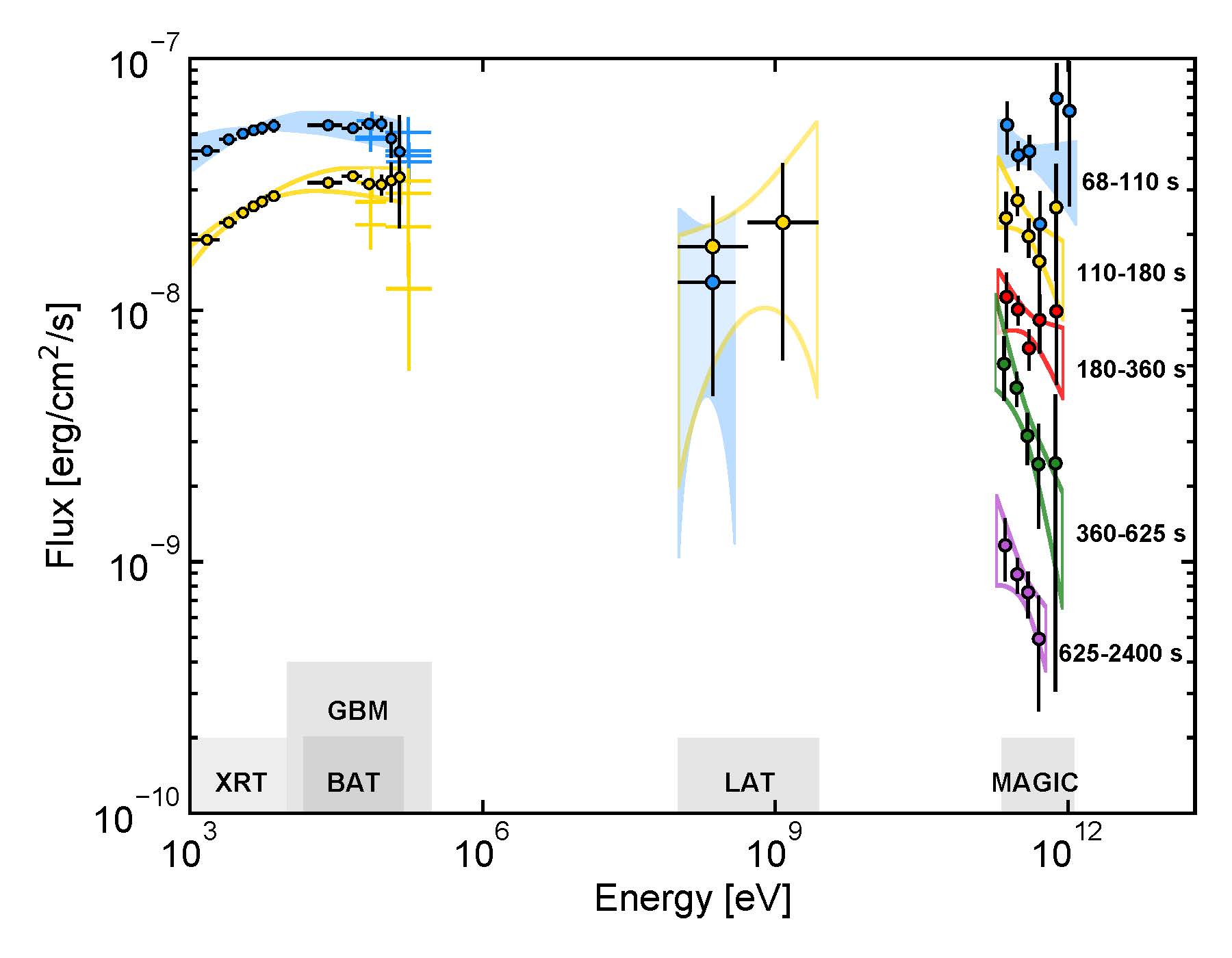
SED development of GRB 190114C in time measured by Swift XRT/BAT, Fermi GBM/LAT and by MAGIC. The MAGIC measurement is split into 5 consecutive periods of time. For the first 2 time bins also the data from the mentioned satellites are shown.
Mirzoyan:
The first measurements show that the afterglow of GRBs is accompanied by the second peak in its spectral energy distribution (SED) at (sub-)TeVs, resembling much the blazars. And this second Synchrotron-Self-Compton (SSC) is pretty energetic, it has a power comparable to that of synchrotron emission at lower energies. This means that until the recent past researchers were missing a substantial part of energy from the GRBs and that these are more powerful than thought before. The presence of the 2nd peak will help us to constrain and pinpoint many physical parameters of GRB jets and of the surrounding medium. We made a significant step towards improving our understanding of GRBs.
Wagner:
Not all GRBs are alike and it is not credible to claim a unique common picture based on two different observations of two different bursts. The interpretation of the GRB180720B data is not straightforward. Both, a standard synchrotron and a standard synchrotron-self-Compton are difficult to reconcile with the data.
And is it relevant to have seen both the prompt and also the after glow emission with respect to the models?
Mirzoyan:
Only a wide field of view (FoV) instrument can observe a GRB in its prompt phase. The narrow FoV instruments like Imaging Air Cherenkov Telescopes (IACTs) also in future would rely on satellite mission alerts on GRBs. MAGIC observation of GRB 190114C started at 58 seconds after the onset of the GRB, so although this should be the in the afterglow phase, a small contribution from the prompt phase cannot be excluded. Our modelling indicates that about half of the radiative output of the GRB 190114C is emitted in the prompt emission phase and the other half in the afterglow phase. The afterglow contains a wealth of information on the interaction of the relativistic jet launched by GRB with the ambient medium. Of course it would be fantastic to observe a GRB in its prompt phase with a ground-based instrument, which covers, for example, an area in excess of 25000 m² (HAWC, LHAASO); the initial rate of gammas would be so high that one needs to carefully design the DAQ system, for preventing its saturation. Observation of the prompt phase with its structured signal at TeVs could provide additional important clues like, for example, to processes when and how a jet is launched and expands, for unravelling the sequence of the complex processes happening at the initial phase of the bursts.
Wagner:
It is extremely important to cover GRBs during the prompt and the afterglow phases. We would have profited a lot from observations of the prompt phase of GRB180720B or longer-lasting observations of GRB 190114C. The two bursts are different and the two data sets do not lead to an unambiguous common scenario. We will need to observe many more bursts in more detail to fully understand the mechanism giving rise to the VHE emission.
Was it a coincidence that both experiments achieved this result at about the same time, or did the technology develop in such a way that such measurements are now feasible and we will be able to measure GRBs more frequently in the future?
Mirzoyan:
The question that in the past year we frequently asked ourselves is why it took so long, say 15 years, to measure a gamma-ray signal from a GRB at TeV? The first answer is that these happen not so frequently at relatively low red-shifts. It is well-known that the strong EBL (extragalactic background light) absorption limits the reach of IACTs at high energies; for example, we estimated that the 1 TeV emission from the GRB 190114C, residing at the red-shift of 0.42, is attenuated by 300 times. The second answer is that the probability is higher that these will happen at large zenith angles (i.e. at energies much higher than the threshold of a given ground-based instrument); one needs to correspondingly plan the reaction of instruments to alerts. The third reason is that one needs to observe a GRB at any, even at barely acceptable ambient lighting conditions, once it is relevant; this further enhances the chance probability. And the last but not least answer is that one needed to show in the first time that in fact, it is do possible to measure a (sub)-TeV signal from a GRB and this is just what MAGIC did. The good thing is that the GRBs will become regular observational targets at (sub)-TeVs and soon the successful measurements will provide wealth of data allowing us to find clues to many puzzling questions about these monstrous explosions.
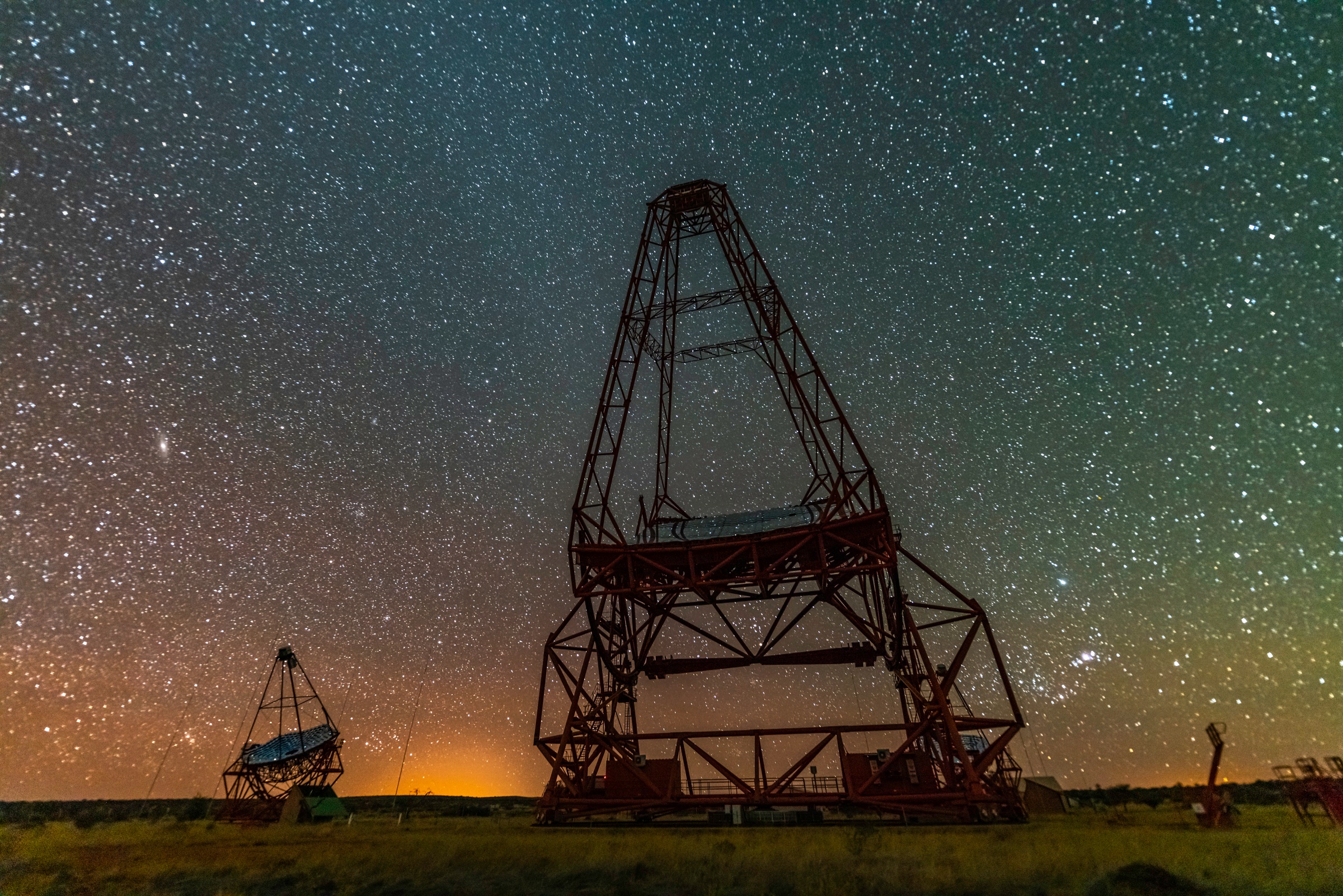
The giant CT5 telescope of the H.E.S.S. array. With its 28m lage main mirror it is by far the largest Cherenkov telecope in the world. Its light gathering power was instrumental for the discovery of the first GRB ever discovered in the VHE band – GRB 180720B. Credit: HESS/Vikas Chander
Wagner:
GRB180720B was an extraordinarily bright burst. Our GRB alert scheme would have identified such an exceptional burst many years earlier and we would have aimed for follow-up observations in case the position of the burst in the sky and weather conditions would have allowed observations. The discovery would have been possible earlier, but such bright bursts are rare. Given the delay of 10 hours after the event before the position in the sky became observable, the CT5 telescope, which started operations about 5 years before GRB180720B, was essential. The technology continuously advances, and the rare GRBs have always been a much sought-after target in the entire community such that any improvement raises the likelihood of successful observations. We are hence optimistic that we will be able to measure GRBs more frequently in the future. As with any rare and unpredictable event, however, one needs to be prepared, alert, – and lucky.
At what point were you aware that you had actually detected GRBs and what are the verifications you needed to do from detection to publication?
Mirzoyan:
We got convinced that in fact MAGIC has measured a monstrous strong signal >20 sigma from GRB 190114C within the first two hours after the alert from the Swift satellite mission, in the late evening of 14th January 2019. In the next morning, while sitting in the plane aiming to Tucson, I was surprised to see ten (10) analyses results, performed by the collaboration members from Spain to Germany, from Italy to Japan. The reported signal strength were in the range 40-60 sigma (this value depends on the used cuts). From that moment on we started carefully evaluating the systematic errors related to our detection. So essentially we looked into diverse technical issues for carefully evaluating the systematic errors. There were no problems related either to signal strength, statistical errors or remaining background (the latter was really negligible). We spent a lot of time for coordinating exchange of data with about two dozen space-born and ground-based instruments, which observed the GRB 190114C, for developing our model of the GRB afterglow emission.
Wagner:
We knew from the start that GRB180720B is an exceptional burst. The information in the initial trigger information clearly identified it as an unusual bright GRB even before the position became visible for H.E.S.S. and this information was folded in when the observational strategy was set. Nonetheless it was a rather faint signal which did not allow an unambiguous detection during the observations. Any H.E.S.S. result is cross-checked using different analyses and flaring events – which cannot be re-observed – require careful control of the trial factors in the analysis. Given the X-ray brightness of the prompt burst it was clear that even an upper limit would provide important constraints and we used a dedicated unblinding procedure for off-line analysis in the weeks following the event. The verification of the analysis and final publication goes much beyond the mere detection and involved spectral and temporal analysis.
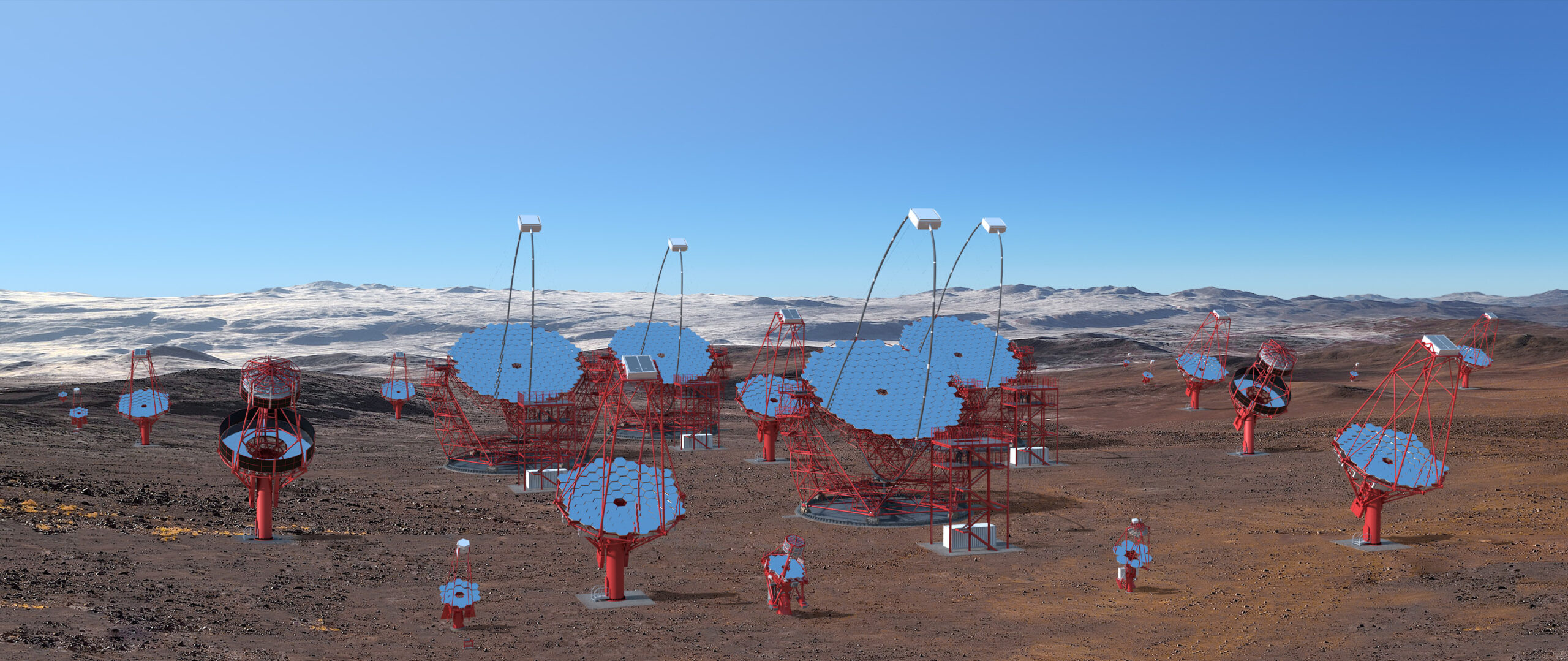
Future CTA Telescopes – This image illustrates all three classes of the 99 telescopes planned for the southern hemisphere as viewed from the centre of the array. While not an accurate representation of the final array layout (the smallest telescopes will be spread just beyond the centre), this rendering illustrates the enormous scale of the CTA telescopes and the array, itself. Credit: Gabriel Pérez Diaz, IAC / Marc-André Besel, CTAO
What do you expect from future experiments like CTA?
Wagner:
GRBs have been one of the key motivations when designing CTA and it is reassuring to see these discoveries now. Some of us started to worry about not having detected GRBs despite the more than decade-long searches with H.E.S.S. and MAGIC. In our discovery paper we address CTA perspectives and estimate that we should detect one GRB with CTA every 4 months on average and be able to observe the afterglow for about 10 bursts every year.
Mirzoyan:
I expect that already the current generation of telescopes will measure a solid sample of GRB emissions in the afterglow phase. The future will become only better with operation of the large number of well-designed and optimised CTA telescopes. One may anticipate that due to the higher sensitivity the CTA telescopes can find fainter GRB emissions and possibly in rather late phases of their emission. The very low threshold of the telescopes will probably not play a decisive role because the GRBs will mostly happen under large observational angles, well above the threshold. Of course it is very much desirable to have a threshold as low as few tens of GeV; this could help to observe the population of GRBs from beyond the red-shift of 1. I anticipate that within the next 10 years we will gain a very solid knowledge on the GRB afterglow and maybe with a piece of good luck in a few cases, also on the prompt phase.
Further reading:
- APPEC news: https://www.appec.org/news/gamma-ray-bursts-with-record-energy
- Homepage of MAGIC: https://magic.mpp.mpg.de/
- Homepage of H.E.S.S.: https://www.mpi-hd.mpg.de/hfm/HESS/
- Publications:
- A very-high-energy component deep in the γ-ray burst afterglow; The H.E.S.S. collaboration; Nature, 2019;
DOI: 10.1038/s41586-019-1743-9 - Teraelectronvolt emission from the γ-ray burst GRB 190114C; The MAGIC collaboration; Nature, 2019;
DOI: 10.1038/s41586-019-1750-x - Observation of inverse Compton emission from a long γ-ray burst; The MAGIC Collaboration; Nature, 2019;
DOI : 10.1038/s41586-019-1754-6
- A very-high-energy component deep in the γ-ray burst afterglow; The H.E.S.S. collaboration; Nature, 2019;

Razmik Mirzoyan
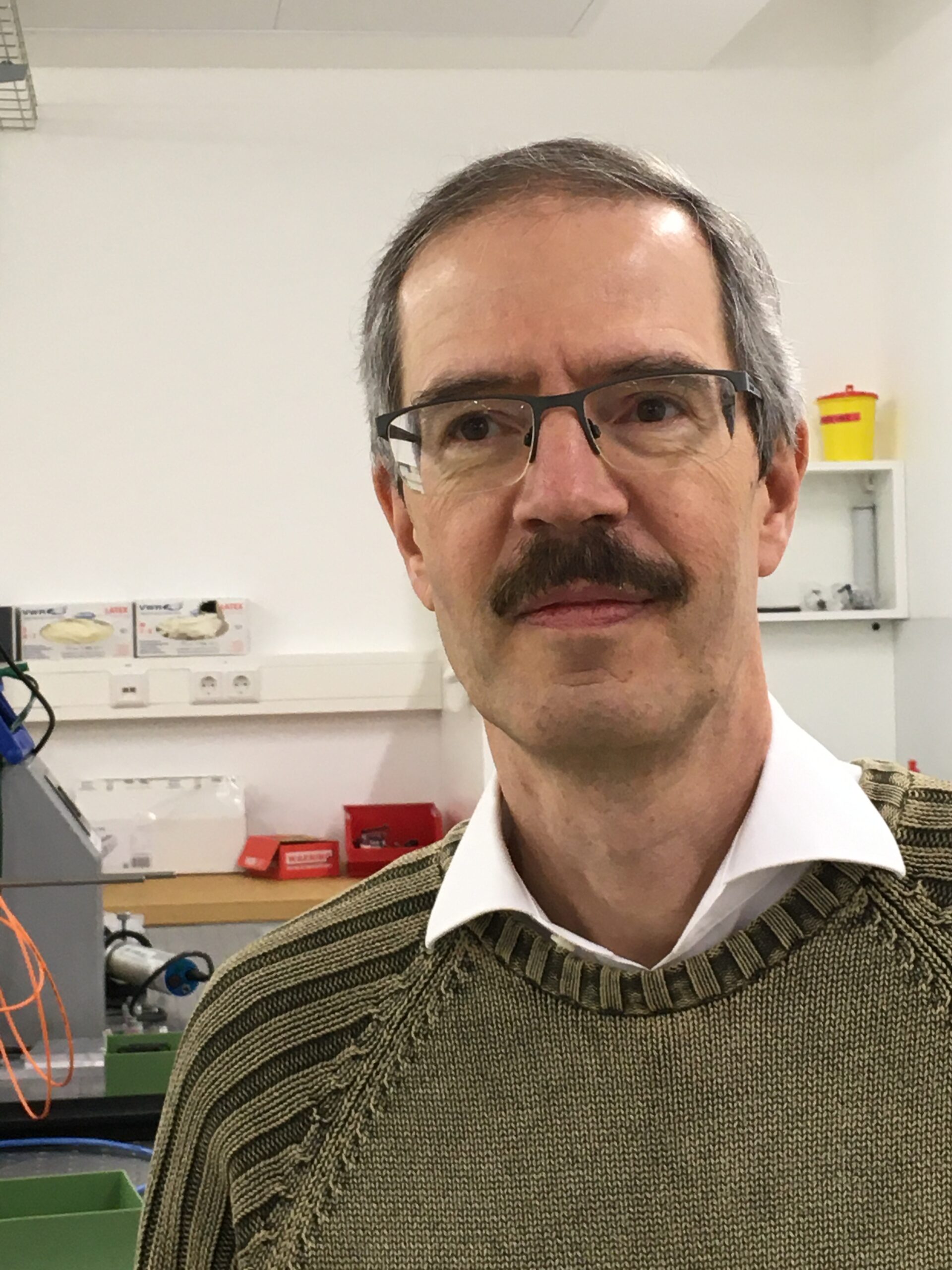
Stefan Wagner
Dr. Razmik Mirzoyan is an astro-physicist, since 1992 working at the Max-Planck-Institute for Physics in Munich, Germany. He is currently the spokesperson of the MAGIC collaboration and the EU spokesperson of the TAIGA collaboration. His main interests are in astrophysics, astro-particle physics, cosmic and gamma rays, cosmology and in photon sensors. He defended his PhD thesis in FIAN in 1984. Since then he is working in the ground-based very high energy gamma-ray astronomy with imaging air Cherenkov telescopes (IACT). He is one of the founders of the HEGRA IACT array (1991-2002) as well as the co-founder of the MAGIC IACTs (2003- till now). He has made strong contributions in fast photo sensors as the classical PMTs, SiPMs, Hybrid Photo-Diodes, significantly improving and boosting their performance. He is co-authoring 15 patents in EU and in a number of foreign countries. He is a honorary professor of Irkutsk State University and a foreign member of the National Academy of Sciences of Republic of Armenia.
Prof. Stefan Wagner is a professor for astrophysics at Heidelberg University and Co-sokesperson of its IMPRS graduate school on astronomy and Cosmic Physics. Having worked mostly of active galactic nuclei he is very much engaged in multi-wavelength studies of non-thermal sources and time-domain astronomy. He co-founded the H.E.S.S. experiment, has coordinated its multi-wavelength working group for many years and is the current director of the H.E.S.S. facility and spokesperson of the collaboration. He has been responsible for CTA governance and hosted the international CTA project office during its design phase.




